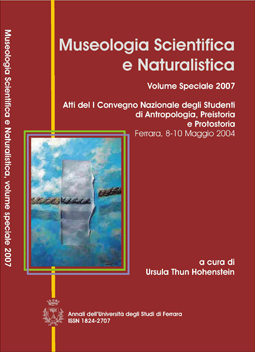Ambiente e Territorio
DOI:
https://doi.org/10.15160/1824-2707/445Abstract
Il neolitico della pianura reggiana. Studi archeobotanici dell'insediamento di Bazzarola (Reggio Emilia)
Carra M. & Ricciardi S.
The prehistoric site of Bazzarola is characterized by three different Neolithic horizons, giving
evidence of a Neolithic occupation which lasted continually for about two thousand years: the “Ceramica
Impressa” culture, the “Fiorano” culture and the “Vasi a Bocca Quadrata” culture. This paper presents the
results of archaeobotanical analysis of samples from nine of the investigated features. [The Neolithic of
Reggiana Plane. Archaeobotanical analysis of the site Bazzarola (Reggio Emilia).]
Le specie d'alce fossile del Pleistocene medio d'Europa come indicatrici cronologiche.
Breda M.& Marchetti M.
Systematics and biochronology of Middle Pleistocene Eurasian moose (Cervidae, Mammalia), made up
of Cervalces latifrons, C. (?) postremus, a badly known form assigned to Alces sp. and the living species
Alces alces, are discussed. Some morphological characteristics of C. (?) postremus are pointed out. [The
Middle Pleistocene Eurasian fossil moose species as chronological indicators.]
La collezione della palafitta di Ledro del Museo di Antropologia dell'Università di Padova: ricostruzione del paleoambiente.
Pinton V. & Carrara N.
The archaeological remains from Ledro constitute one of the most important collections for their
number, variety and state of conservation which are currently preserved at the Museum of Anthropology of
the University of Padova. They were collected by prof. R. Battaglia during the 1937 excavation campaign.
According to the archaeological conclusions and the 14C dating, the lake-dwelling was built between 2000
and 1800 BC and abandoned between 1500 and 1200 BC. The collection is composed by 1296 catalogued
pieces of different materials: animal and human bones, botanical remains, lithic artefacts, horn and bone
objects, terracotta, bronze, wood and tissue fragments.
Considering Battaglia’s report (1943), Dalla Fior’s pollinic analysis (1940) and Riedel’s archaeozoological
study, the collection was revisited according with the modern methodologies, trying to reach a better
comprehension of the ancient environment in the valley of Ledro. The museal collection confirms presences
of typical mountain flora and fauna and a strong human action in order to improve agriculture and breeding,
two important economical activities at time. Landscape was probably characterized by brushy forest with a
band without trees round the lakeside utilized in agriculture. [The collection of Ledro lake-dwellings of the
Museum of Anthropology of the University of Padova: palaeoenvironmental reconstruction.]



